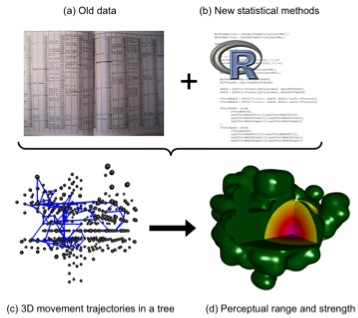Updated: 24/04/2025
Many animals locate resources and orient in rather complex environments like vegetation, coral reefs or leaf litter. How does the presence of a stimulus affect animal movement in such complex environments? And what is the relative contribution of a stimulus vs. the complexity of the environment on animal movements? Find out in the Early View paper “Relative roles of resource stimulus and vegetation architecture on the paths of flies foraging for fruit” by Oriol Verdeny-Vilalta and co-workers.
Below is the author’s summary of the study:
To answer the questions above, we developed a novel method using random walks on graphs to accurately estimate both the perceptual range and the attraction strength from 3D movement trajectories of individuals. The perceptual range gives us an idea of the maximal distance at which a stimulus source biases the movement. The attraction strength measures how the attraction of the stimulus varies at different distances within the perceptual range. Additionally, the methodology enabled us to calculate the relative roles of the architecture of vegetation and of the strength of attraction of a stimulus on the movement of individuals. We applied the methodology to estimate perceptual range and strength of apple maggot flies (Rhagoletis pomonella) foraging for artificial fruit in apple trees of varying complexity.
Figure: Main steps (a-d) followed to study animal orientation in complex vegetation structures.
In our study we have shown that, conditional on visiting the stimulus location, the presence of the fruit affects animal movement much more than the plant architecture. Moreover, we found that plant complexity makes a minor contribution to defining the perceptual range, but a large contribution to the attraction strength. Thus, we highlight the importance of estimating not only the perceptual range but also the attraction strength of animals, which has been traditionally neglected. Our findings have implications for studying foraging ecology and landscape connectivity. For example, several dispersal models developed to study landscape connectivity incorporate the perceptual range of individuals, but the distinction between perceptual range and attraction strength is still lacking. We expect that landscape connectivity will be higher in animals showing higher attraction strengths for equal perceptual ranges. Given that animals use their sensory systems to make informed decisions and that they move and interact in heterogeneous environments, our approach might be of relevance to the myriad of animals walking and searching in complex environmental structures.

